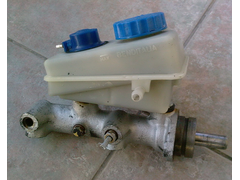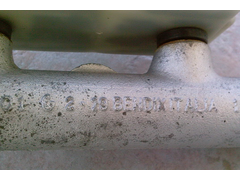
Brake system calculation
Echidna - 9/10/08 at 07:17 PM
I have used Adams Brakes excel spreadsheet to analyze my brake system.
FYI, in the front i will use the 4-piston Wilwood Powerlite kit and at the rear probably the stock Sierra read-disc setup.
I tried to enter the info of my car as accurately as possible.
I assumed the following:
1) Total car weight = 1200lbs = 550kg (it will be a BEC)
2) Front weight split = 45%
3) CoG height = 13in
4) Max deceleration for slick tyres = 1.0g
Given data:
1) Wheelbase = 92in
2) Pad friction coefficient = 0.4
3) Brake pedal ration = 6.30:1
4) Wheel rolling radius = 10.67 (22/54-13 tyres)
5) Effective braking radius - front=4.368in - rear=4.1
6) Fixed front brake caliper, floating rear
7) 4 pistons front, 1 piston rear
8) 1.38in front piston diameter, 1.685in rear piston diameter
9) Brake pedal input force = 50lbs (lower than the recommended by the program)
The ideal tandem MC will be 1.00"
Could you please review my analysis? Is there anything done or calculated wrong?
Echidna - 9/10/08 at 07:20 PM
And here is the xls file
http://www.wikiupload.com/download_page.php?id=65473
britishtrident - 10/10/08 at 07:03 AM
At a first glance sanity check you need a much smaller master cylinder piston area.
britishtrident - 10/10/08 at 07:39 AM
After crunching the numbers it would be more like 120 lbf on the pedal for a 1 g stop with a 1" dia master cylinder.
Take as a guide you need to be able generate about 720 to 750 psi hydrualic line pressure in the brakes. This about half the hydraulic line pressure
you would see in a normal tintop.
Also make sure your assumption on pedal leverage is measured from the centre of the pedal pad --- a leverage of 6.3 is very diffult to get in the
restricted space available.
hughpinder - 10/10/08 at 11:27 AM
According to my calcs you are about right -
In your weight calc have you allowed for a passenger and maximum fuel, luggage etc?
I also think you may end up with a lower pedal ratio, but guess you could fit larger diameter discs and higher friction pads to sort it out.
I seem to remember reading somewhere that an non aero can exceed 1g deceleration on the road, due to surface roughness of tarmac. Was it
something like the elise that managed 1.2g in a test somewhere?
Like all such calculations, I would allow at least 10% overdesign!
Regards
Hugh
britishtrident - 10/10/08 at 01:12 PM
I made a error of factor 2 in calculating the clamping force in my rough calcs corrected which would give 60 lbf force at the pedal. BUT looking
over various assumption on things like friction coefficients, contribution from rear brakes and pedal ratio I would think this would be a real world
80lbf plus for a 1 g stop.
Over 80 lbf pedal force is really not fun to drive with.
My reasoning for the pedal pressure being higher than calculated is
(1) I am assume the 0.4 friction coefficient you were using is for warm brakes -- better to use 0.3 or 0.33 as on light car the pads may
not get up working temp.
(2) The pedal ratio issue has alread been covered.
(3) Because of the dangers of premature the rear brakes can never used to their max stopping power.
Both Caterham and Westfield use 0.7" dia master cylinders --- I would recommend you use a cylinder in the 0.75" to 0.81" bore
range.
Echidna - 10/10/08 at 02:23 PM
Thanks for the suggestions guys, i really appreciate it!
I will check again my brake pedal ratio as soon as i arrive home from work and follow up to inform you.
As for the pad friction coefficient, i actually use Wilwood's PolyMatrix E compound, which has an almost flat friction curve over a large
temperature range. It starts at 0.4 at 100F, max of 0.47 at around 550F and stops at 0.44 at 1000F. It has a really nice curve. All data are from
Wilwood.
So, in my calcs i have used the worst scenario as far as friction coefficient is concerned.
I think it's better to start off with a stock used and very cheap Ford Sierra MC which is 0.875in, test it and if i see that my brakes are OK but
the pedal is soft and the travel long, i will buy a Wilwood 1in MC.
If not, i will buy a brand new Sierra MC, or even try an even smaller one.
@britishtrident
"Both Caterham and Westfield use 0.7" dia master cylinders"
Do they use tandem MC's?
Echidna - 10/10/08 at 04:41 PM
You guys are right. My brake pedal ratio is not 6.3. It seems that it was a figure from a previous file save and then i thought it was the right one!

My pedal ratio is 5.4
Also i upped the weight of the car to compensate with a heavy passenger and full tank.
Here is the revised file and it seems that the ideal MC will be 0.875in. 
http://www.wikiupload.com/download_page.php?id=65699
[Edited on 10/10/08 by Echidna]
britishtrident - 10/10/08 at 08:53 PM
Why don't you look at Polo/Golf Mk1/Mk2 non-servo master cylinders -- dirt cheap from Euro Car Parts. or Brakes Int although you need to get a
resevoir from the scrappies.
Also look at the Skoda Estelle cylinder from Brakes Int again dirt cheap so if you find the pedal pressure is too high you can swap either out
from a Fiesta Mk 1 nos servo or cortina 1300 Mk3 non servo cylinder very easily and without msajor financial outlay.
britishtrident - 10/10/08 at 08:58 PM
quote:
Originally posted by Echidna
T
"Both Caterham and Westfield use 0.7" dia master cylinders"
Do they use tandem MC's?
Yes both Wesfield and Caterham have online parts stores with pictures.
Pretty sure the Westie uses the master cyilnder from a povery spec Mk1 Fiesta 997/1100 cc non-servo model.
Tip ---- cylinders designed for non-servo appications have two mounting bolts in a vertical line as on Girling & Lockheed single circuit
cylinders.
[Edited on 10/10/08 by britishtrident]
Echidna - 11/10/08 at 02:34 PM
@britishtrident
Finally i found an even more cheap option. I have just removed the brake MC from my old unused now Alfa Romeo 33.


Rescued attachment MC1.jpg
Echidna - 11/10/08 at 02:38 PM
It seems identical to that shown in BrakeParts.co.uk
One concern though. There were two types of MCs for the Alfa33. One with a diameter of 20.6mm = 0.811in and the other with a diameter of 19mm =
0.748in
Looking at the number "19" at the photo i think that my MC is the 19.0mm one.


Rescued attachment MC2.jpg






